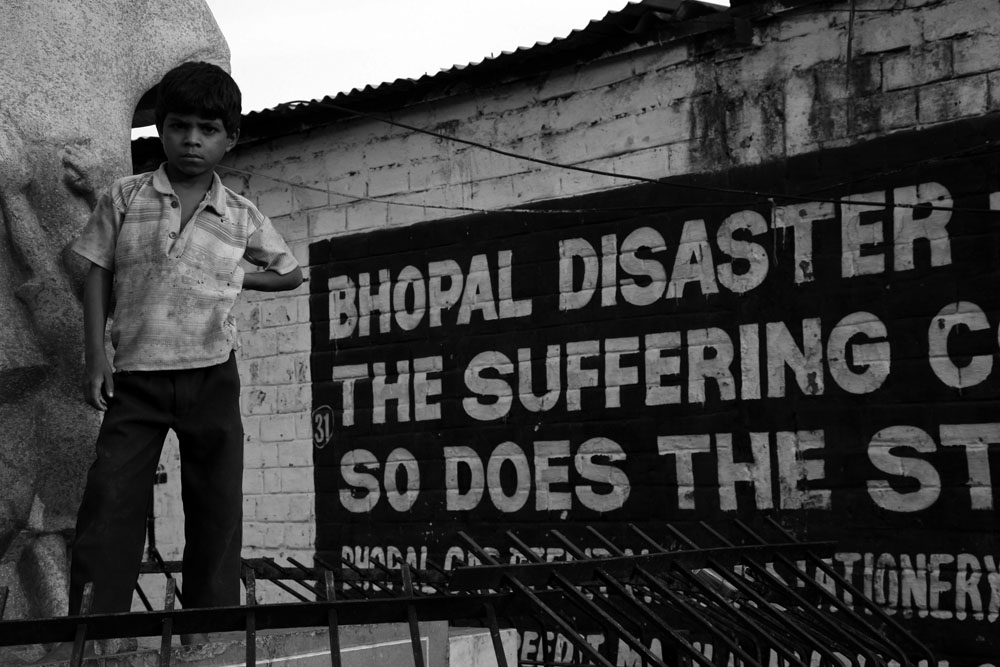Bhopal disaster. The story
THE GAS DISASTER
On the night of December 2nd, 1984, a Union Carbide plant in Bhopal, India, began leaking 27 tons of the deadly gas methyl isocyanate. None of the six safety systems designed to contain such a leak were operational, allowing the gas to spread throughout the city of Bhopal [1]. Half a million people were exposed to the gas and 25,000 have died to date as a result of their exposure. More than 150,000 people still suffer from ailments caused by the accident and the subsequent pollution at the plant site.
These ailments include blindness, extreme difficulty in breathing and gynaecological disorders. The site has never been properly cleaned up and it continues to poison the residents of Bhopal. In 1999, local groundwater and well-water testing near the site of the accident revealed mercury at levels between 20,000 and 6 million times those expected. Cancer, brain-damage and birth-defect-causing chemicals were found in the water; trichloroethene, a chemical that has been shown to impair foetal development, was found at levels 50 times higher than EPA safety limits [2].Testing published in a 2002 report revealed poisons such as 1,3,5 trichlorobenzene, dichloromethane, chloroform, lead and mercury in the breast milk of nursing women [3]. In 2001, Michigan-based chemical corporation Dow Chemical purchased Union Carbide, thereby acquiring its assets and liabilities. However Dow Chemical has steadfastly refused to clean up the site, provide safe drinking water, compensate the victims or disclose the composition of the gas leak, information that doctors could use to properly treat the victims.
The Agony of Bhopal
No one will ever know exactly how many thousands died that night. Carbide says 3,800. Municipal workers who picked up bodies with their own hands, loading them onto trucks for burial in mass graves or to be burned on mass pyres, reckon they shifted at least 15,000 bodies. Survivors, basing their estimates on the number of shrouds sold in the city, conservatively claim about 8000 died in the first week. Such body counts become meaningless when you know that the dying has never stopped. More detail HERE
The Union Carbide factory in Bhopal was doomed almost from the start. The company built the pesticide factory there in the 1970s, thinking that India represented a huge untapped market for its pest control products. However sales never met the company’s expectations; Indian farmers, struggling to cope with droughts and floods, didn’t have the money to buy Union Carbide’s pesticides. The plant, which never reached its full capacity, proved to be a losing venture and ceased active production in the early 1980s.
However, vast quantities of dangerous chemicals remained; three tanks continued to hold over 60 tons of methyl isocyanate, or MIC for short. Although MIC is a particularly reactive and deadly gas, the Union Carbide plant’s elaborate safety system was allowed to fall into disrepair. The management’s reasoning seemed to be that since the plant had ceased all production, no threat remained. Every safety system that had been installed to prevent a leak of MIC – at least six in all – ultimately proved inoperative (see Figure 1, below).
Regular maintenance had fallen into such disrepair that on the night of December 2nd, when an employee was flushing a corroded pipe, multiple stopcocks failed and allowed water to flow freely into the largest tank of MIC. Exposure to this water soon led to an uncontrolled reaction; the tank was blown out of its concrete sarcophagus and spewed a deadly cloud of MIC, hydrogen cyanide, mono methylamine and other chemicals that hugged the ground. Blown by the prevailing winds, this cloud settled over much of Bhopal. Soon after, people began to die.
Remembers Aziza Sultan, a survivor: “At about 12.30 am I woke to the sound of my baby coughing badly. In the half light I saw that the room was filled with a white cloud. I heard a lot of people shouting. They were shouting ‘run, run’. Then I started coughing, with each breath seeming as if I was breathing in fire. My eyes were burning.”
Another survivor, Champa Devi Shukla, remembers that, “It felt like somebody had filled our bodies up with red chillies, our eyes had tears coming out, noses were watering, we had froth in our mouths. The coughing was so bad that people were writhing in pain. Some people just got up and ran in whatever they were wearing or even if they were wearing nothing at all. Somebody was running this way and somebody was running that way, some people were just running in their underclothes. People were only concerned as to how they would save their lives so they just ran.
source: https://www.bhopal.org/
